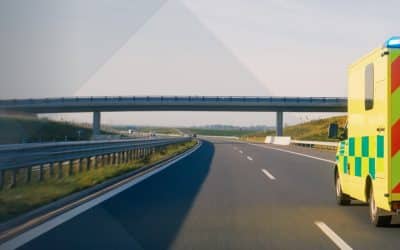
What is Telematics?
According to Gartner, wireless Telematics devices and “black box” technologies collect and transmit data on vehicle use, maintenance requirements and automotive servicing.
How does Telematics work?
A Telematics system or remote vehicle diagnostic (RVD) system requires a device installed in your vehicle that allows the sending, receiving and storing of telemetry data. It connects via the vehicle’s own onboard diagnostics (ODBII) and communicates to the vehicle CANBus with a SIM card, and an onboard modem enables communication over the GPRS network (General Packet Radio Service).
The device collects vehicle data and other vehicle-specific information such as GPS and transmits it via GPRS 2G/LTE-M mobile data and cellular network or satellite communication to a hosted server. Through business intelligence, the data is interpreted and displayed for end users via secure websites and apps optimized for smartphones and tablets.
The Telematics data captured can include location, Revs, vehicle speed, idling time, harsh acceleration or braking, fuel consumption, vehicle faults, and more. When analysed for particular events and patterns, this information can provide in-depth insights across an entire fleet.
How are Telematics devices installed?
Vehicle manufacturers are starting to install embedded GPS tracking and telematics technologies directly in their fleet vehicles, and are mainly focussed on providing vehicle data to consumers which allows you remote access to your vehicle via your smartphone or another smart device. If a vehicle does not come with this technology pre-installed, aftermarket Telematics devices are available for installation. These can be battery-powered or powered via the vehicle’s own internal electrical system.
The device connects to the onboard diagnostics (OBD-II) port or CAN bus port with a SIM card, whereby many Fleet Management operators/leasing companies partner with Telematics providers to provide a seamless end-user experience, ordinarily installed prior to delivery to improve customer experience and digital journey. In the coming years, it’s likely that the automotive industry will continue to develop smart cars that use Telematics to deliver better results for their customers. These systems will also capitalize on the emerging Internet of Things (IoT) landscape that can help connect vehicles to cities and smart traffic technologies.
How can my fleet use Telematics systems?
Telematics services can interface with existing applications and third-party solutions to enable multiple data collection for fleets of all sizes, including:
-
Vehicle tracking:
Vehicles can be tracked using a combination of GPS satellites and receivers, GPRS networks and cloud computing. A GPS receiver downloads information from GPS satellites and processes it for use with applications, it transmits that information via GPRS to the web servers used by office-based staff, where it can be used to dispatch the nearest driver to a new job.
-
Maintenance improvements:
Vehicle maintenance and service event management can be improved by using fleet Telematics to schedule preventative maintenance, as well as warranty, breakdown recovery, and collision detection. Fleet managers can decrease vehicle of the road time (VOR) and keep vehicles roadworthy by receiving real-time engine diagnostics, including battery voltage, powertrain malfunctions, MIL light status and much more.
-
Driver Behaviour:
Managers can use fleet Telematics to monitor vehicle speed and location, as well as harsh driving events and accurately determine risk factors and adjust insurance premiums. Telematics provides a digital driver profile of every aspect of a vehicle’s operation, helping fleet managers understand where improvements can be made in accident prevention measures and driver safety standards.
What Data is recorded?
The advanced Telematics systems in the market today, collect information from the vehicle CANBus and instrument clusters to support with data credibility and to an evidential standard data. Traditional GPS tracking solutions use calculation methods from positioning and speed with a 95% probability accuracy, but GPS depends on many factors. When using a Telematics device these datasets are typically provided by the vehicle:
- Location
- Maintenance Diagnostic trouble codes
- Fuel consumption
- Idling time derived from Key status
- Instances of harsh driving (e.g., hard braking or cornering)
- Speed and rapid acceleration
The Future Ahead
Automotive Telematics has been around since the early 2000s and will continue to expand during 2022, improving management and efficiency of businesses with a vehicle fleet – it has moved to the forefront of the automotive industry, particularly during the pandemic. The word Telematics is formed by the combination of telecommunications and informatics. The advancements in Telematics technology are continuing to evolve as market shifts and vehicles become more advanced with new innovations resulting in improved efficiencies and reduced costs, whilst improving safety.
The Covid-19 pandemic required the fleet industry to adopt vehicle Telematics systems to monitor their fleets remotely, Information transmitted can include data on vehicle use, maintenance requirements, automotive servicing, crashes and accidents, and the location of stolen vehicles. This clearly outlines how this transforms and digitises fleet management.
The global automotive Telematics market is set to experience rapid growth in the coming years, with approximately 104m, or 88%, of new cars expected to have some form of connectivity by 2025. The UK presents huge growth opportunities due to the advancements in the field of IoT for vehicles (IoV) and Telematics are impressive.
Data from this technology are also making the management process more streamlined and with the Internet of Things (IoT) it is crucial for businesses to benefit from trends in vehicle Telematics to gain an edge. Fleet management systems enable users to control business operations such as; Remote vehicle diagnostics, mileage reporting, insight-led deployment, data-driven workflows, improved fuel consumption, and reduced CO2 emissions.
Vehicle Telematics works by simply adding connectivity to a vehicle, in the majority cases installing an aftermarket device that allows remote access to vehicle data like location, speed, fuel usage, and vehicle performance in real-time, and customers are wanting that information faster and more accurately than ever before. Corporate fleets in the UK are already starting to use this data to help reduce the insured save on their policies, implementing a form of gamification to promote correct driving standards.
The IoV, or Internet of Vehicles, is the next step in the evolution of vehicles. Big Data from vehicles such as; driver profiling and sharing data from other vehicles we open the door to possibilities like intelligent deployment, predictive maintenance and AI traffic management.
The latest GSM changes are reshaping Vehicle Telematics. 5G and LTE-M technology is faster, improved bandwidth, reduced latency, and more reliable. Along with IoT hardware and computing power, 5G technology can unlock new opportunities for in-vehicle connectivity.
The next-gen of vehicles will expand embedded with IoT-, producing a huge amount of data continuously. Telematics can give instantaneous information such as; vehicle health, its mileage, enabling fleet managers to investigate the data to reduce downtime and repair costs.
Concurrently, cloud technology needs to continue to improve to store, handle, and process huge amounts of data. Cloud solutions can ensure remote monitoring, operational analysis, and improved customer service, making Telematics solutions more dependable. Additionally, fleet managers can access data from anywhere today, thanks to the cloud.
Conclusion
With the growing amount of data from internal and external sensors, securing it all is a huge challenge. Hence, we can also predict the need for future solutions that focus on data security in-vehicle Telematics and GPS tracking systems.
As with any technology, there are constant improvements in system, hardware, software, and infrastructure such as satellite systems, as well as the power of 5G. In the future, this technology will evolve to use 5G to provide even more information, both from a safety and economic perspective, making an even more valuable contribution to the business world.
Celebrating a decade of excellence: Airmax Remote renews ISO 9001:2015 accreditation
We are delighted to announce that Airmax Remote has successfully renewed our ISO 9001:2015 accreditation for the supply of advanced telematics and vehicle diagnostic systems within the UK. This year marks a significant milestone as we celebrate 10 years of continuous certification under this internationally recognised standard, underscoring our solemn commitment to diligence, regulatory conformance, quality and excellence.
Airmax Remote becomes signatory to The Police Industry Charter
This March, AirMax Remote proudly became one of the founder signatories to The Police Industry Charter, a landmark initiative spearheaded by BlueLight Commercial alongside key stakeholders such as the NPCC, APCC, RISC, the Home Office and the Office of the Police Chief Scientific Adviser.
Airmax Remote Ltd to showcase its advanced fleet telematics solutions at the 49th NAPFM event
Airmax Remote Ltd, a leading provider of advanced fleet telematics solutions for the emergency...




